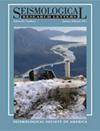使用密度自适应 DBSCAN 算法改进地震聚类:伊朗实例
IF 3.2
3区 地球科学
Q2 GEOCHEMISTRY & GEOPHYSICS
引用次数: 0
摘要
DBSCAN是一种广泛应用于聚类和空间数据分析的无监督机器学习算法。然而,该算法的准确性高度依赖于其超参数的选择,最小样本(Smin),形成聚类所需的最小点数,以及点之间的最大距离。在这项研究中,我们提出了一种改进的DBSCAN算法,通过引入一个事件密度图来取代Smin和ε。通过该方法,我们将超参数的数量从2个减少到1个,N代表事件密度图中的单元数,简化了优化过程,加快了优化速度。因此,算法的优化将得到改善,因为唯一要考虑的因素是每个单元的大小。此外,动态Smin的利用将提供更有效的聚类,因为它更适合具有可变地震密度的地区。我们使用伊朗地震目录来测试算法,并将结果与Mirzaei et al.(1998)模型作为评估标准进行了比较。由于该算法允许集群之间的密度对比,因此在研究新区域的分区时,它可以成为一个很好的指标。这些发现比其他方法更加一致,并可能为了解伊朗的地震构造提供额外的见解。除地震研究外,该算法还可以应用于科学和工程的多个领域,用于变密度聚类的数据集聚类。本文章由计算机程序翻译,如有差异,请以英文原文为准。
Improved Earthquake Clustering Using a Density-Adaptive DBSCAN Algorithm: An Example from Iran
DBSCAN is a widely used unsupervised machine learning algorithm for clustering and spatial data analysis. However, the accuracy of the algorithm is highly dependent on the selection of its hyperparameters, minimum samples (Smin), the minimum number of points required to form a cluster, and ϵ, the maximum distance between points. In this study, we propose a modification to the DBSCAN algorithm by introducing an event density map replacing Smin and ε. Through this method, we decrease the number of hyperparameters from two to one, N which represents the number of cells in the event density map, simplifying, and speeding up optimization. As a result, the optimization of the algorithm will be improved as the sole factor to consider is the size of each cell. In addition, the utilization of dynamic Smin will provide more effective clustering because it is better suited to regions that have a variable earthquake density. We used the Iranian earthquake catalog for testing the algorithm, and we compared the outcomes to the Mirzaei et al. (1998) model as a standard for evaluation. Because this algorithm allows for density contrasts between clusters, it can be a good indicator when studying the zonation of a new area. The findings were more consistent than those of other methods and may offer additional insight into the seismotectonic of Iran. Other than earthquake studies, this algorithm can be applied in multiple fields of science and engineering for clustering datasets with variable-density clusters.
求助全文
通过发布文献求助,成功后即可免费获取论文全文。
去求助
来源期刊

Seismological Research Letters
地学-地球化学与地球物理
CiteScore
6.60
自引率
12.10%
发文量
239
审稿时长
3 months
期刊介绍:
Information not localized
 求助内容:
求助内容: 应助结果提醒方式:
应助结果提醒方式:


